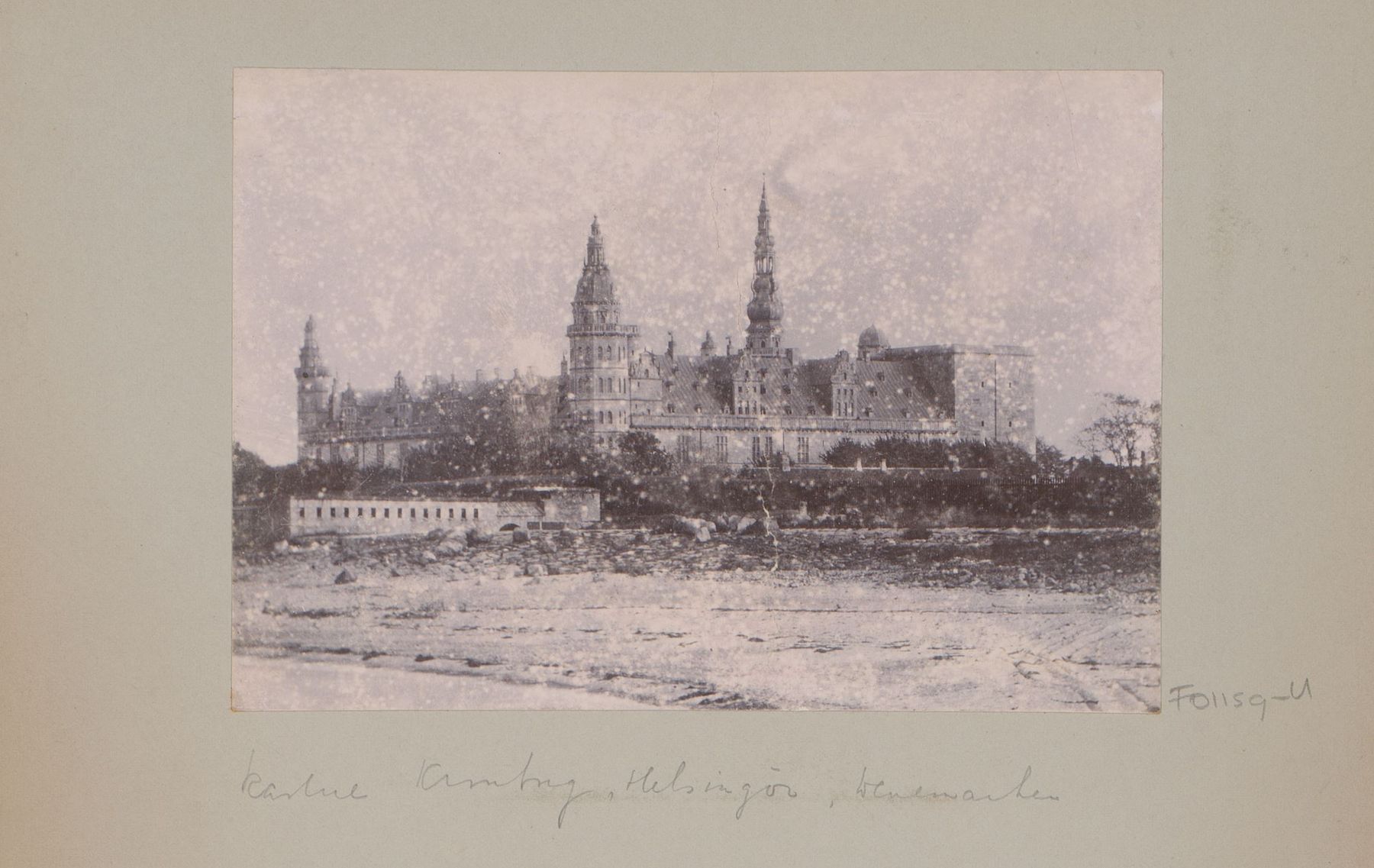A few weeks ago I shared a survey for the Mirror of the Self test similar to the one we went over in class. A couple dozen of you filled it out, and some even added comments about why they chose what they chose (thank you!). Here are the results.
Two Streetscapes
This was the most lopsided pairing:
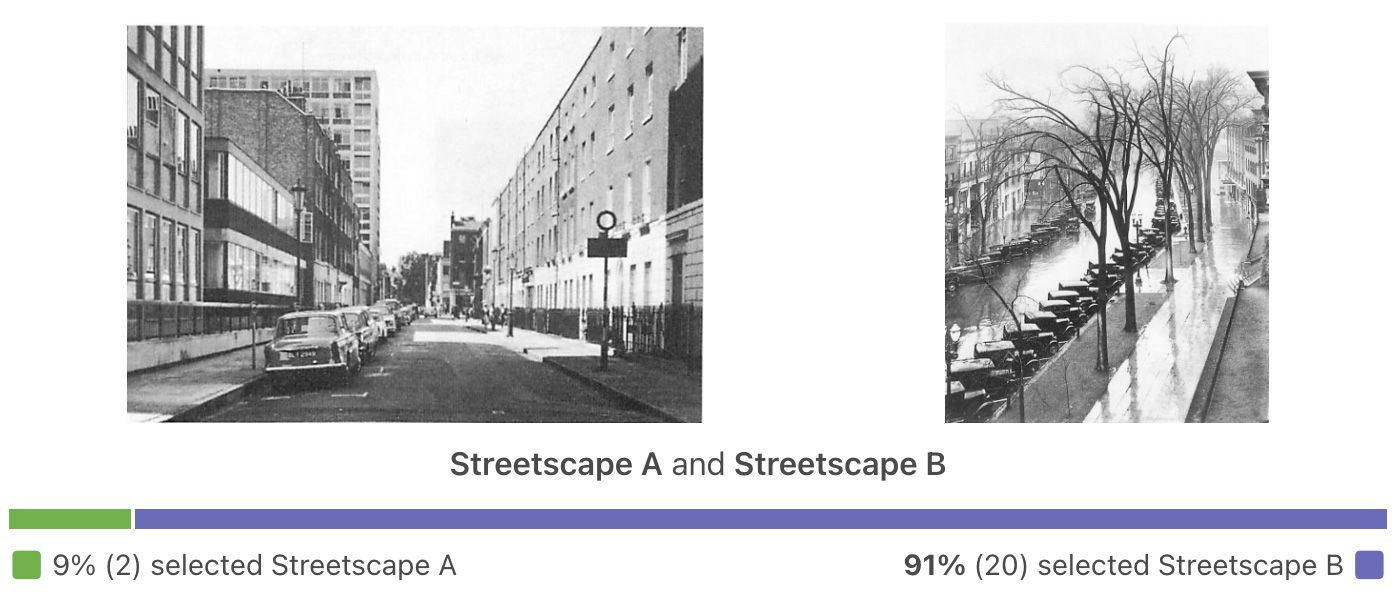
A couple commenters mentioned the effect of the water, which we talked about in class as probably having tipped the scale in heavy favor of B. I liked what one person (46/M/United States) wrote about its melancholy:
The rain of B, the sadness, but not a depressing one. Just one that invites for reflection. The sadness that invites you to reflect on what you have done to continue growing and developing.
Two Houses
The most even split was between the traditional Swedish sod-roof house and the modern cylindrical house by Mario Botta:
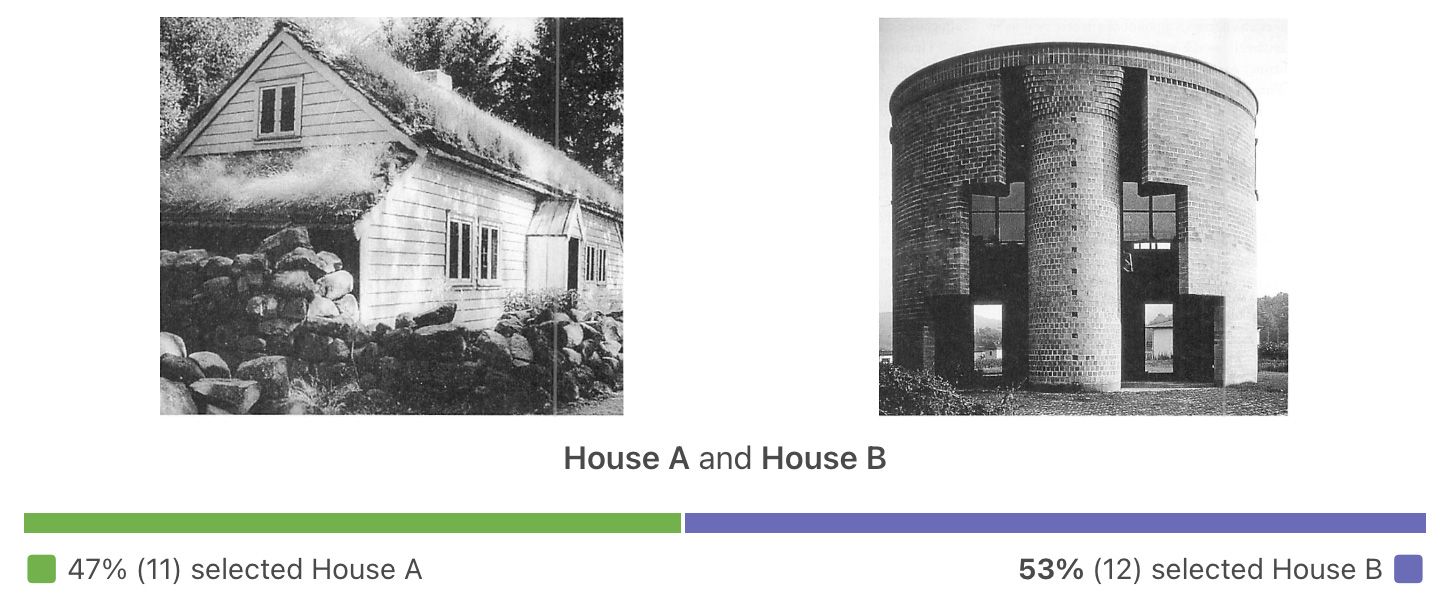
This was surprising, because in class we were almost unanimously in favor of the turf roof house (Alexander also favors the turf house). I can see a few reasons for this. One is that I intentionally hid the book’s captions that provide more detail about these two houses, so as not to sway folks with language. A possible side effect was that it potentially made the Swedish house on the left seem un-cared-for. One respondent (49/F/Canada) summed it up like so:
I appreciate the bold weirdness of the round building. Even though the cottage looks cozier, it also feels decrepit, where as the round building - everything feels intentional
What I haven’t mentioned until now is that the survey also tracks the amount of time it takes people to decide between each paring as a way of estimating how difficult a choice is. This particular pairing was marked “Very Easy,” meaning it took folks very little time to decide. It was obviously one or the other.
Two Matisse Paintings
This pair, on the other hand, took folks the longest amount of time to decide between:
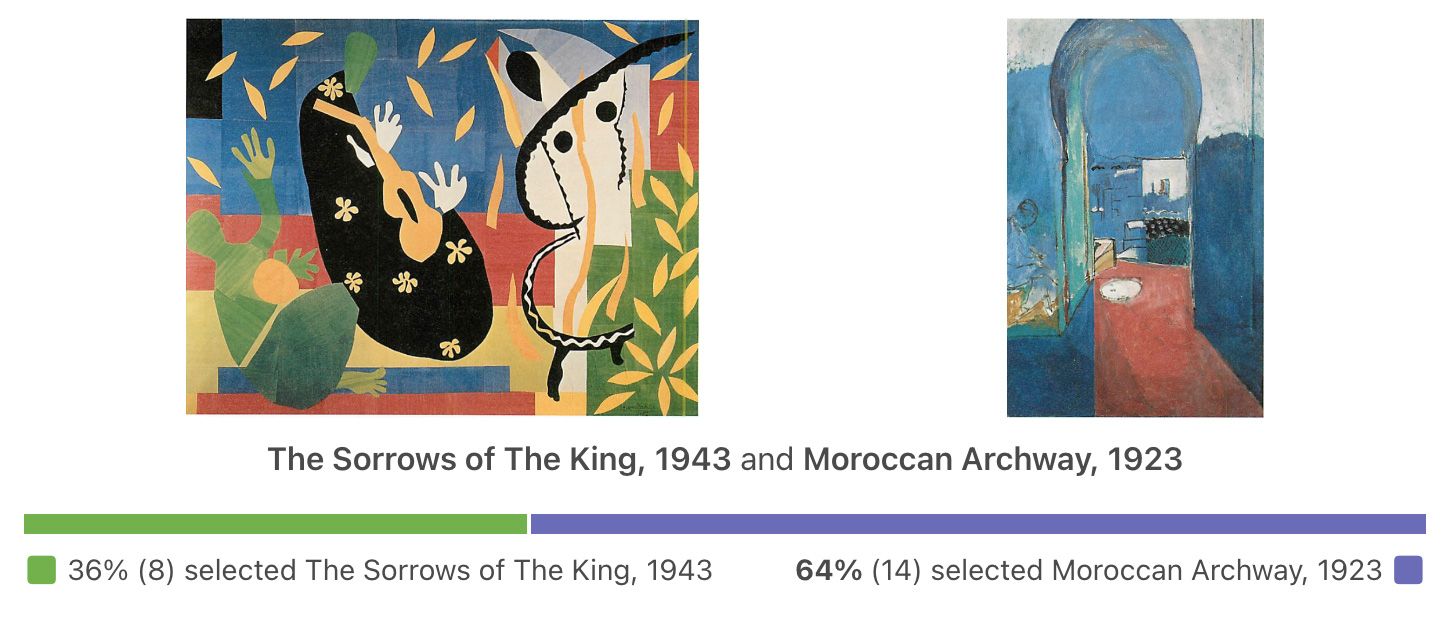
I went for the Moroccan Archway for similar reasons as respondents – the calm, soothing blue. There’s something disturbing to me about the frilly black sickles in the other image. Our class also favored the Moroccan Archway, but Alexander ends up favoring the latter:
The Sorrows of The King cut paper is at first alarming, disquieting. Slowly its majesty sinks in. After years of looking at it, even if the Moroccan painting if more beautiful, I believe the Sorrows comes much closer to a picture of the eternal self.
Two Buildings
Here was an interesting one. Our class results were flipped, two thirds in favor of Building B:
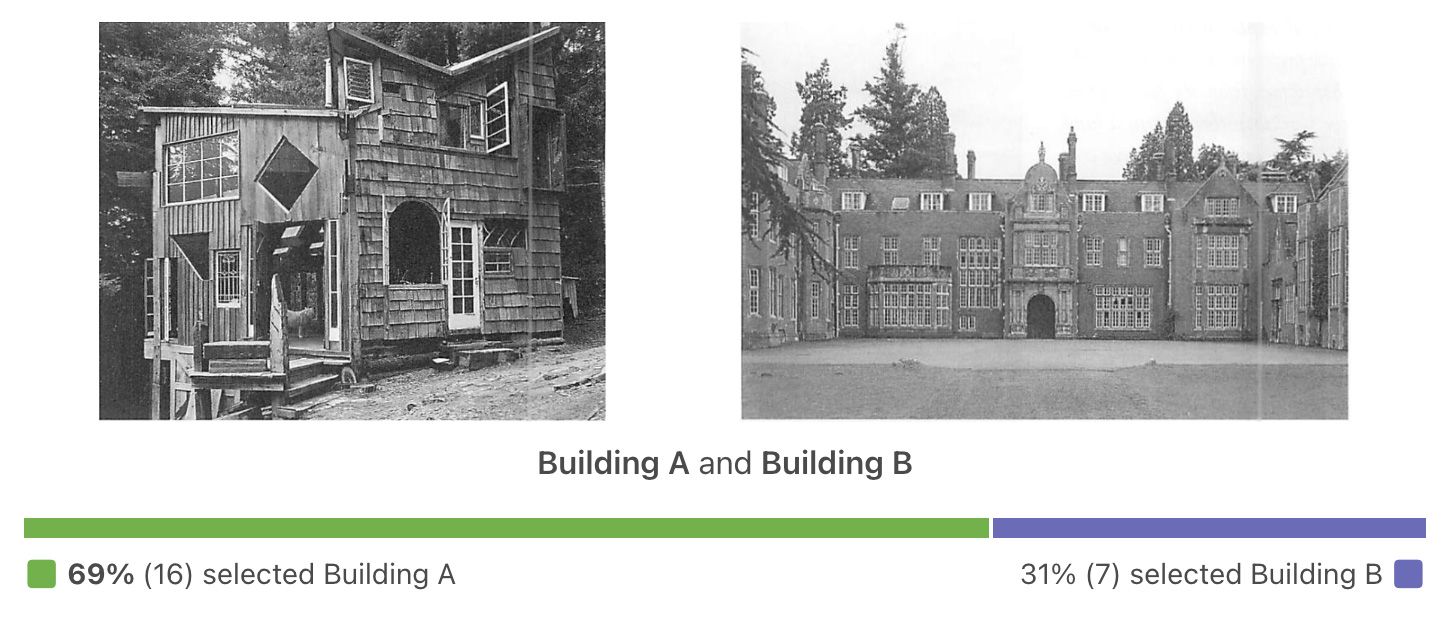
The informal “hippie” house is weirder, which some people liked. The formal manor – Hardwicke Hall – is more ordered and calm. One person (39/M/United States) wrote:
Building B is put together and sense of order. Building A is made up of many parts but it all works. Building B feels like what I'm supposed to relate but building A reflected as correct.
When I asked the “mirror” question, I got the opposite result; I found that formal house was a better mirror on my own self, despite my usual preference for more informal, handmade buildings. Alexander picks the manor too, and disagrees about the cohesion of Building A:
What we see in the hippie house, all kinds of window sizes and shapes, different volumes, roof shapes, create a feeling of arbitrariness, where not enough mass or matter has been felt to glue them together to create a whole. [...] the hippie house is a fashion construct dictated by the rules of an era to express “freedom,” to react against the established order; and therefore, as a construct that expresses only reaction, does not succeed in connecting to deeper feelings.
“Deeper feelings” is an important distinction. Alexander’s not talking about preference, or what’s more aesthetically pleasing, or what you can picture yourself living in, or even what reflects your personality right now. He’s trying to get at your “eternal self” – the you across the totality of your life, through old age (even if you have not yet reached old age). The goal, from what I’ve garnered through this course, is to try and forget all your associations with style or memory and respond purely by this deep feeling to the physical geometry – as if what you’re looking at is an abstract painting.
I know that when first sent you the survey, I said to freely share with friends who might not be familiar with the class. I wonder how much the lack of additional context around the mirror question and the definition of “your true self" influenced the results.
A Bench and a Stool
Here was one that came out, in class, slightly more strongly in favor the blue bench (80/20):
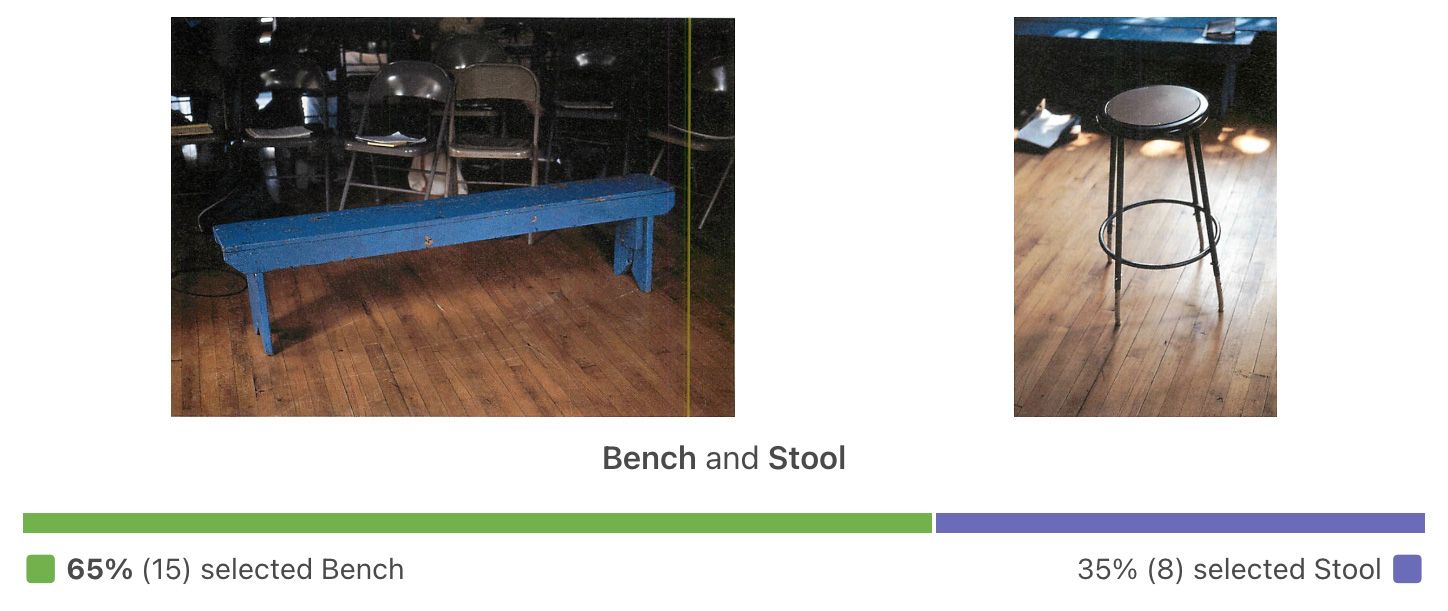
There was a wide range of justifications for choices – some folks responded to the lighting, the way the stool was spotlit, while others responded to the communal nature of the bench or its sturdiness. One person (53/F/United States) had positive associations with the stool: “This decision was easy, I gravitated towards the chair, as it represented school.” I personally think of high school chemistry lab when I see the stool – but that’s not necessarily a positive association!
Alexander tells an anecdote in a book about the origin of these two photos – a conference he spoke at in 1985, where he spontaneous conducted the test with the audience. The result then was 99:1, in favor of the bench. Even the person who’d picked the stool changed their mind weeks later, once the question was reframed for them in terms of “Which feels more nourishing?”
Apples and Oranges
It might seem like in some cases that we’re comparing apples to oranges. Take these two, the Eames House on the left and the quaint chocolate shop on the right.
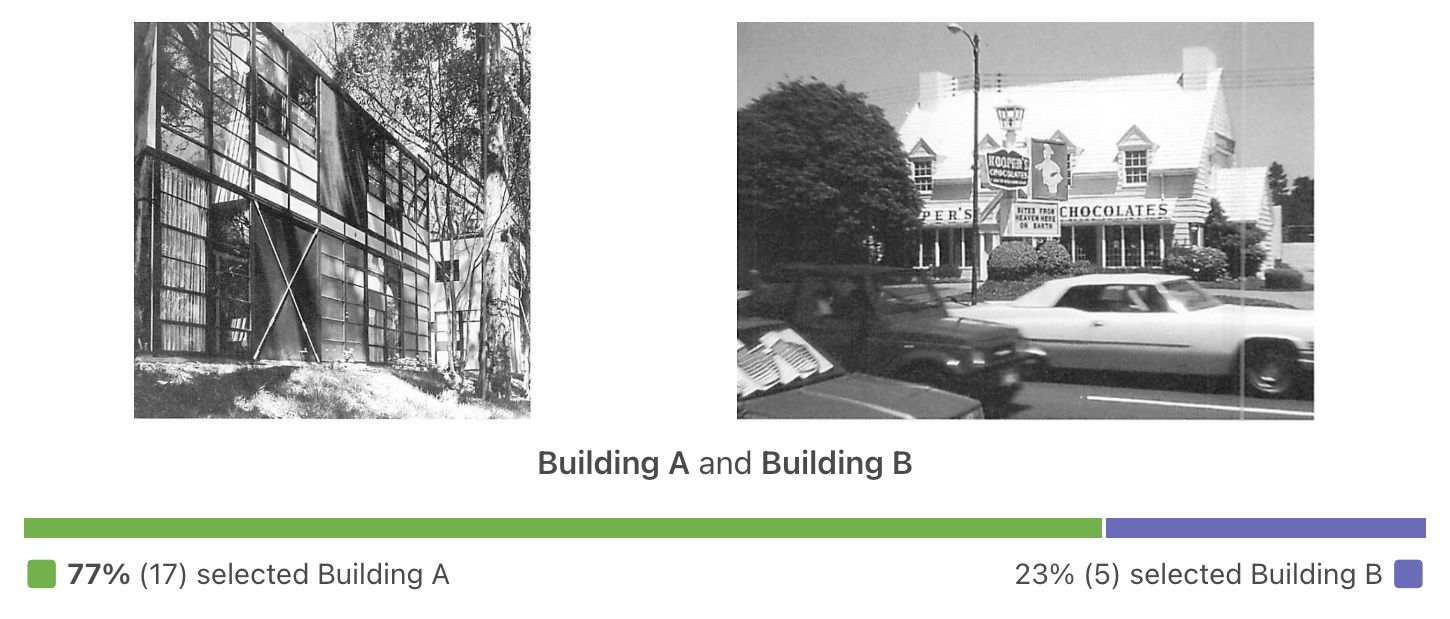
One respondent said this was the pairing they understood the least. But I think it’s telling of what Alexander asks us to gauge with this test: the feeling each evokes in us, in our bodies, independent of its function or category. You can compare apples and oranges in this way, by comparing the feeling each evokes in us.
A modern equivalent of this might be the Kondoan prompt, “Does it spark joy?” Regardless of what you plan to do with the thing in front of you, regardless what memories and attachments you have with it, does your whole being light up in its presence? In our case, neither alternative might elicit that from you, but does one spark more strongly than the other?
I wonder, for instance, how the results here might have differed had the storefront on the right not been clearly identified, as several respondents wrote about their fondness for pizza:
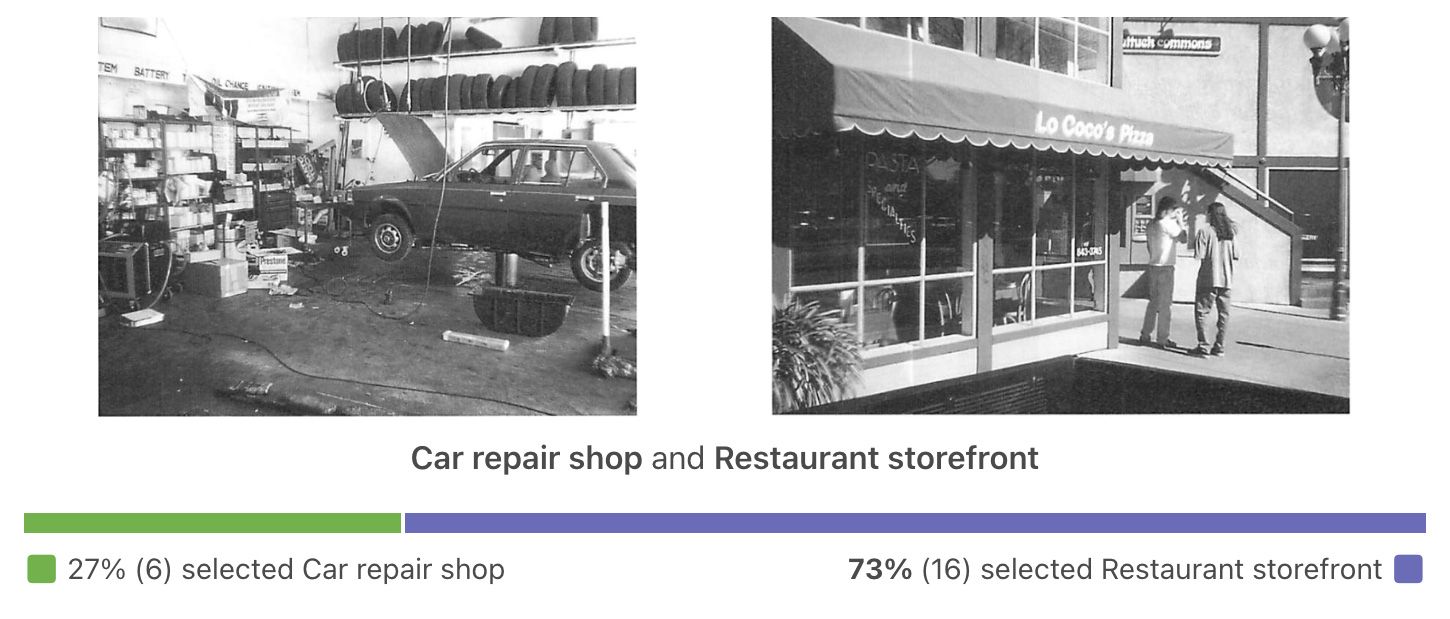
The Rest
Here are remaining pairings, along with select comments from survey takers and how this compared to what our class and Alexander chose:
Two Frank Lloyd Wright Buildings (Class/Alexander: A):
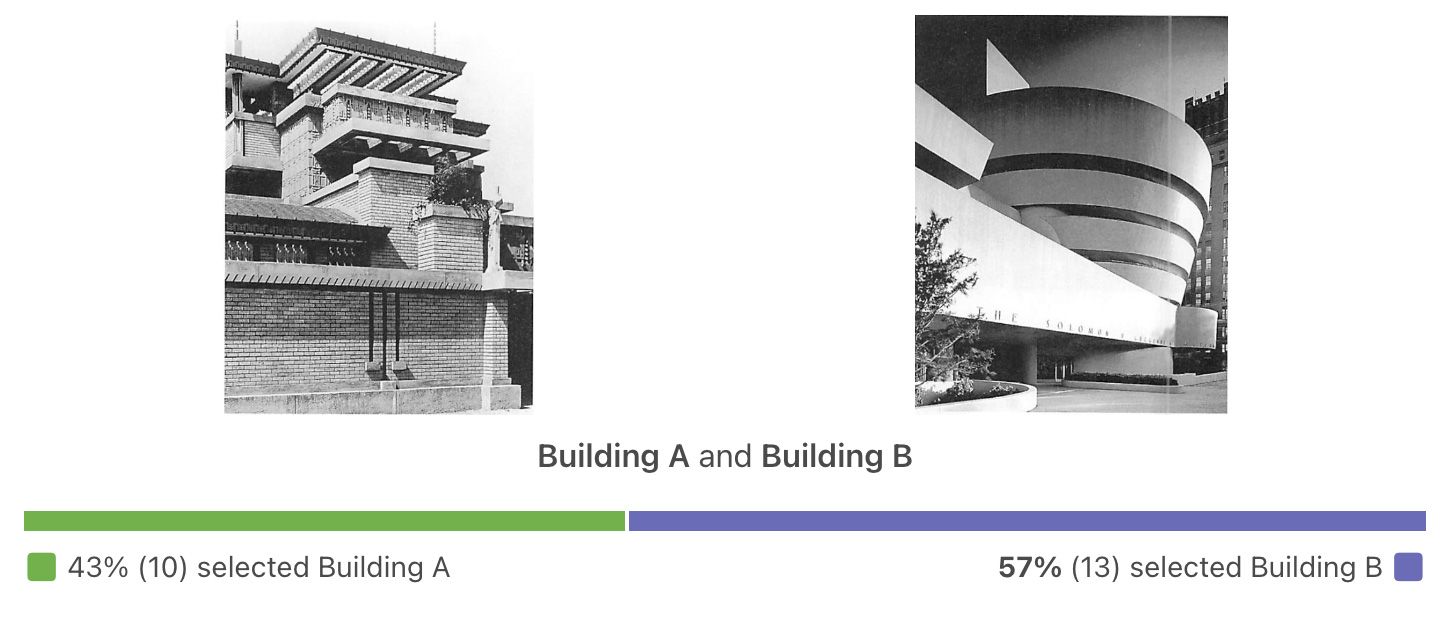
The smoothness and familiarity drew me towards Building B. (53/F/United States)
Two arches (Class: A; Alexander: B):
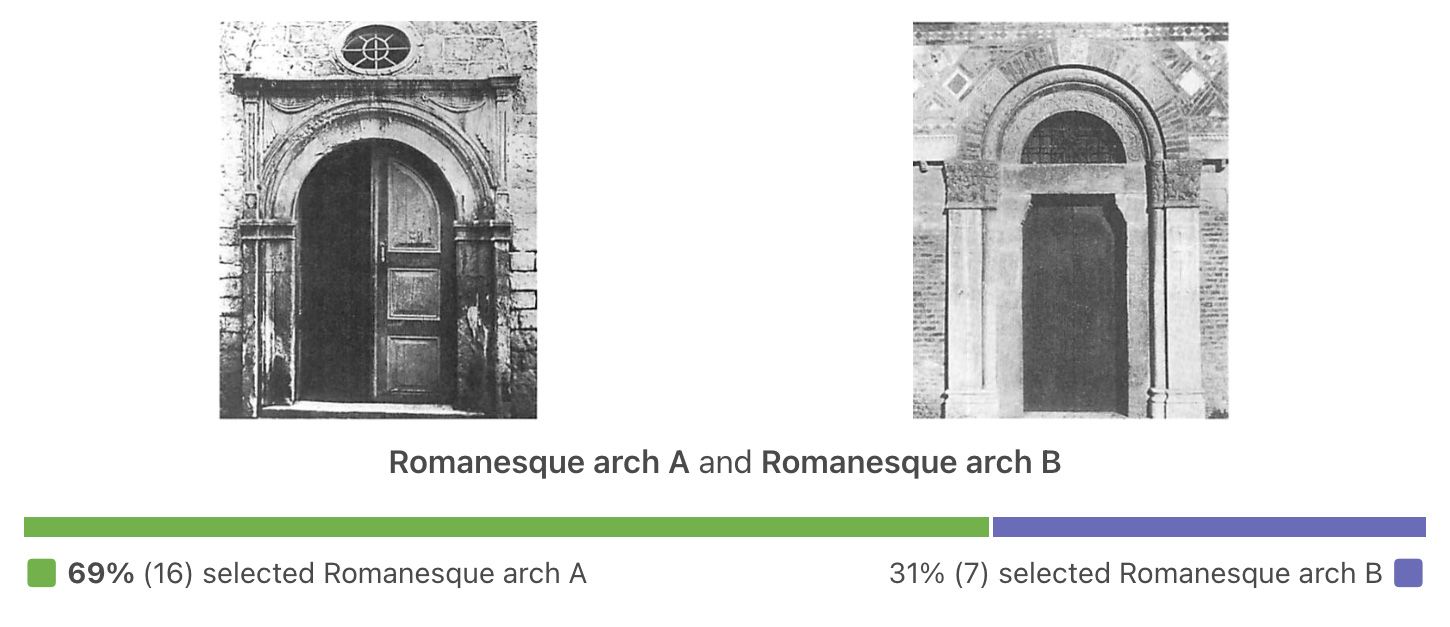
I like the proportions of [Arch A] - the door is open and feels like an invitation in. The other arch feels like the entry way to a mausoleum.(49/F/Canada)
Two cups (Class: not tested; Alexander: B):
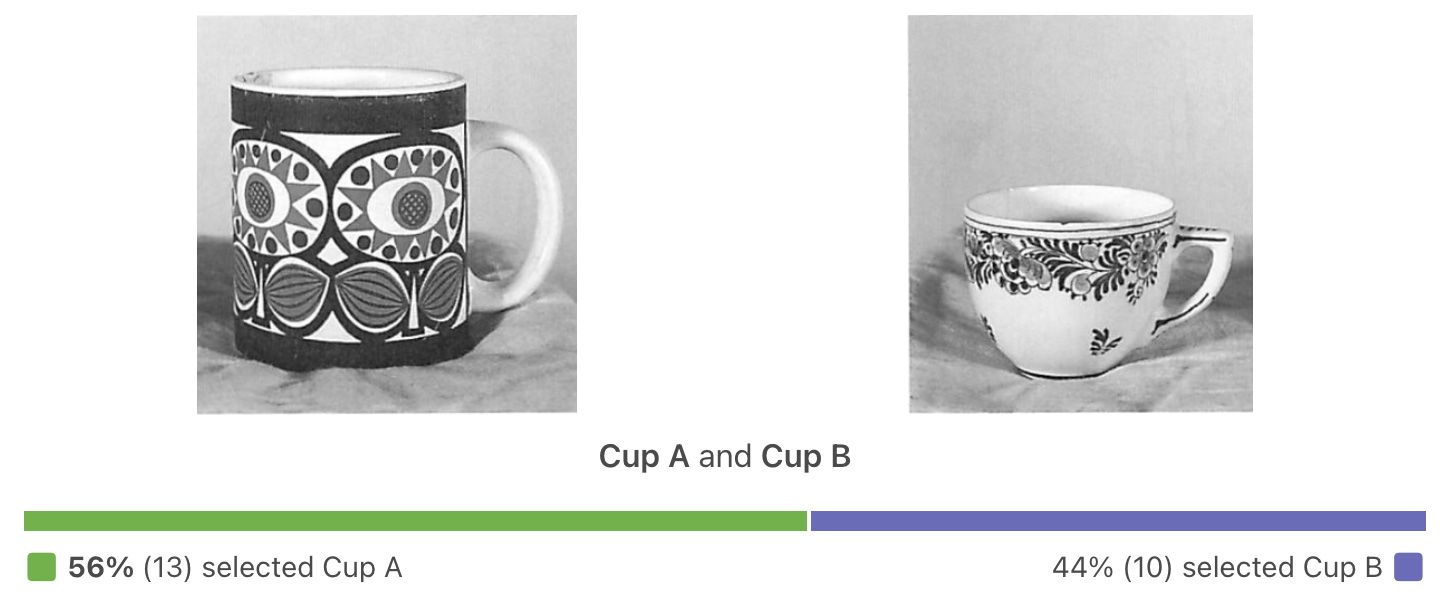
I took the longest time with this one. Like the traditional architecture vs. the haphazard shack, I'm not much like either, but slightly more like Cup B. (60/M/United States)
Jar and Vase (Class: not tested; Alexander: Vase):
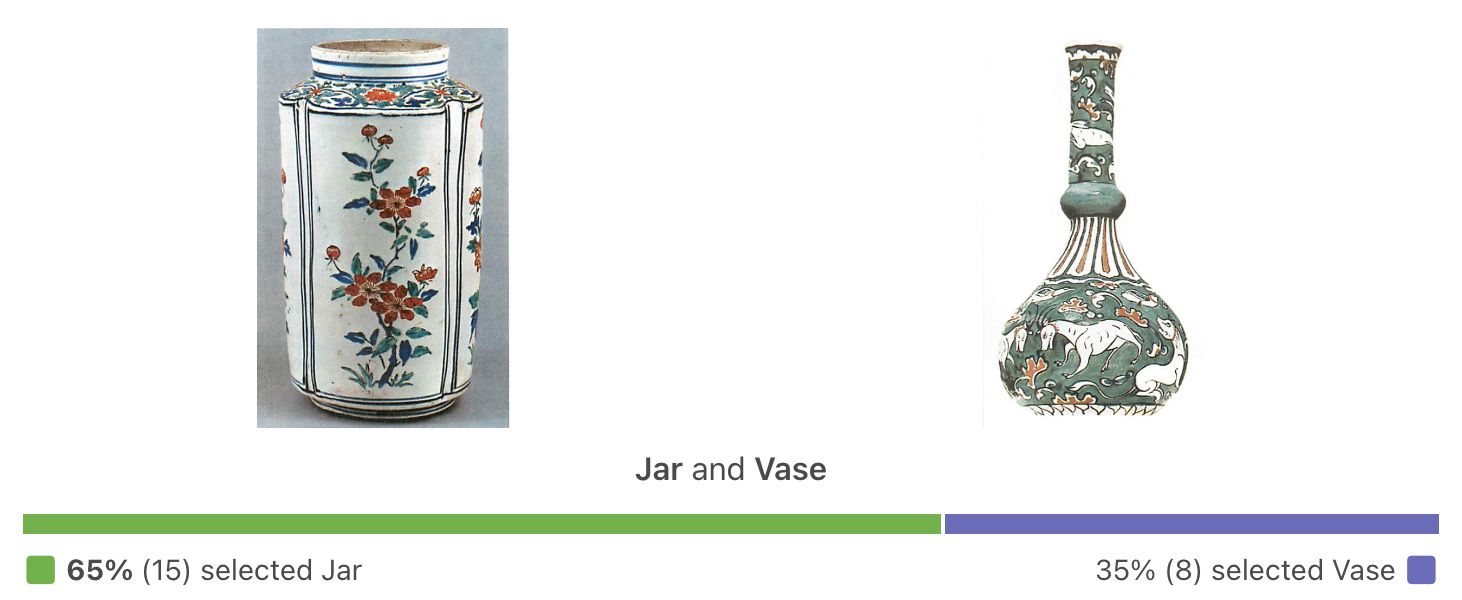
This particular test was challenging. My visceral response could not guide me in my decision. I actually had to reflect on the two objects which then made me focus on the task itself, which object is a better picture of my true self? I saw the vase more in alignment with my other choices, but did not “feel” the same way as the other tests. In the end, I was drawn towards the jar, but felt “disappointed,” in the choice. Maybe what I saw in the jar was a sense of monotony that I didn’t get when looking at the jar. (53/F/United States)
Two rugs (Class/Alexander: Ersari):
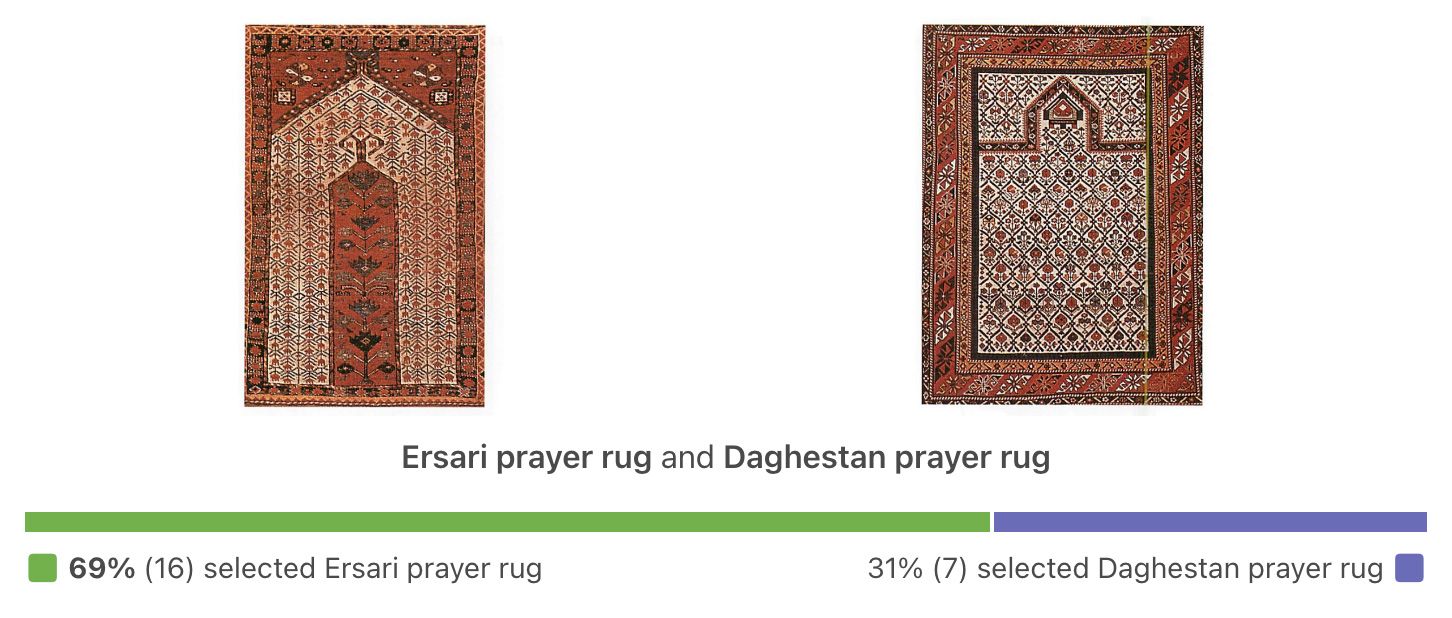
Choice [of Daghestan rug] was based on being drawn to the one large field rather than a split field. I wouldn’t say this one was an easy choice but tried not to think much about it and go with what resonated. (39/M/United States)
A Conclusion ... Somewhat
So does this prove or disprove Alexander’s theories about how beauty can be objectively measured? I’m not so sure either way. When we did these tests in our class, including many other pairings not included in my survey, the pairings that did have consensus tended have stronger consensus. This could be because, as mentioned above, we were more primed to the exact type of “deep feeling” that Alexander is trying to get us to identify.
Or it could be that having read the books and seen the examples in them, we’ve learned the forms and aesthetic that Alexander favors, and are picking the ones that fit what we think he would like.
Or maybe since we’re naturally drawn toward those types of art and architecture – enough that we signed up for the class – that our tastes are more in line with Alexander’s to begin with.
I’m also not entirely sold on the notion that you can really peel back all the layers of association and look at a thing or space free of thought or memory. Or at least not easily. Even the mirror of the self test, Alexander admits, requires practice – perhaps years of practice – in order to hone your sensitivity.
I’m reminded here, too, of what Niels Bohr said to fellow physicist Werner Heisenberg upon visiting Kronborg Castle in Denmark:
Isn’t it strange how this castle changes as soon as one imagines that Hamlet lived here?
